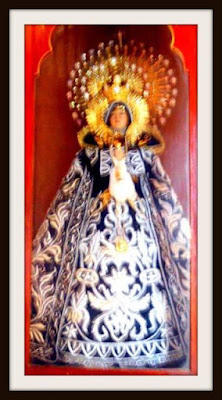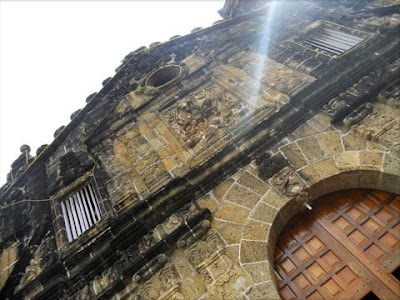Cheering the Our Lady of Sorrows of Pakil
Pakil, Laguna is known for its miraculous yet, capricious image of the Nuestra Señora de los Dolores de Turumba or the Our Lady of Sorrows of Turumba.
Legend has it that the image of Our Lady, a nine-inch by 11-inch oil on canvas, belonged to some Spanish missionaries who encountered a shipwreck while crossing Laguna de Bay during a huge storm. The image was retrieved by a group of fishermen on September 15, 1788. Believing that it was a religious relic, the fishermen decided to bring it to the church of San Pedro de Alcantara, located in Pakil.
 |
| The original image is enshrined in the retablo of a prayer room on the second floor. |
However, the winds would not cooperate. So the fishermen took a different route on which they were able to sail smoothly. They laid the image of the grieving Virgin, with a dagger on her heart, on the top of a flat rock, prompting a group of women to curiously regard the image. They were surprised to see that the canvass was dry despite having just come from the lake. Moreover, they realized it grew very heavy--so heavy that not even the biggest woman named Mariangga could not lift it.
 |
| The statue of Our Lady's wardrobe consists of exquisite dresses donated by different families. As each dress is worn only once, shards of cloth are given to pilgrims for their protection. |
Up to this day, Pakilenos commemorate this miraculous event by paying tribute to Our Lady as a means of sharing her grief and, in my opinion, of cheering her on. Illustrious families in Pakil spend for her statue's made-to-order dresses that are worn only once while thousands of devotees visit her during her procession in the yearly town fiesta. At the same time, the Virgin continues her miracles, which has benefited our elder tour guide many times, having survived several strokes and heart attacks over the years.
 |
| The procession of Turumba somehow mirrors that of the Black Nazarene in Quiapo. Indeed, Filipinos are some of the most fervent devotees in the world! |
Postscript: Developing a devotion to the Our Lady close to five years since my visit to Pakil helped me appreciate her humility and simplicity. These characteristics establish what are truly miraculous and what may be just a town's best-kept legend.
About the Pakil Church
 |
| The facade of Pakil Church. Photo Credit: Mole on My Sole |
San Pedro de Alcantara, more known as the Pakil Church, is one of the best-preserved baroque churches in the Philippines. It took 35 years to complete the church in 1684. Since then, the church has survived fires, disasters and wars, at the same time, keeping the miraculous image of the Virgin intact.
 |
| The Marker Inscription |
 |
| The Main Altar and Sanctuary |
 |
| The ceiling was breathtaking. |
except the Pakil Church Facade which was credited to Mole in My Sole
Originally written on January 21, 2012




Comments
Post a Comment